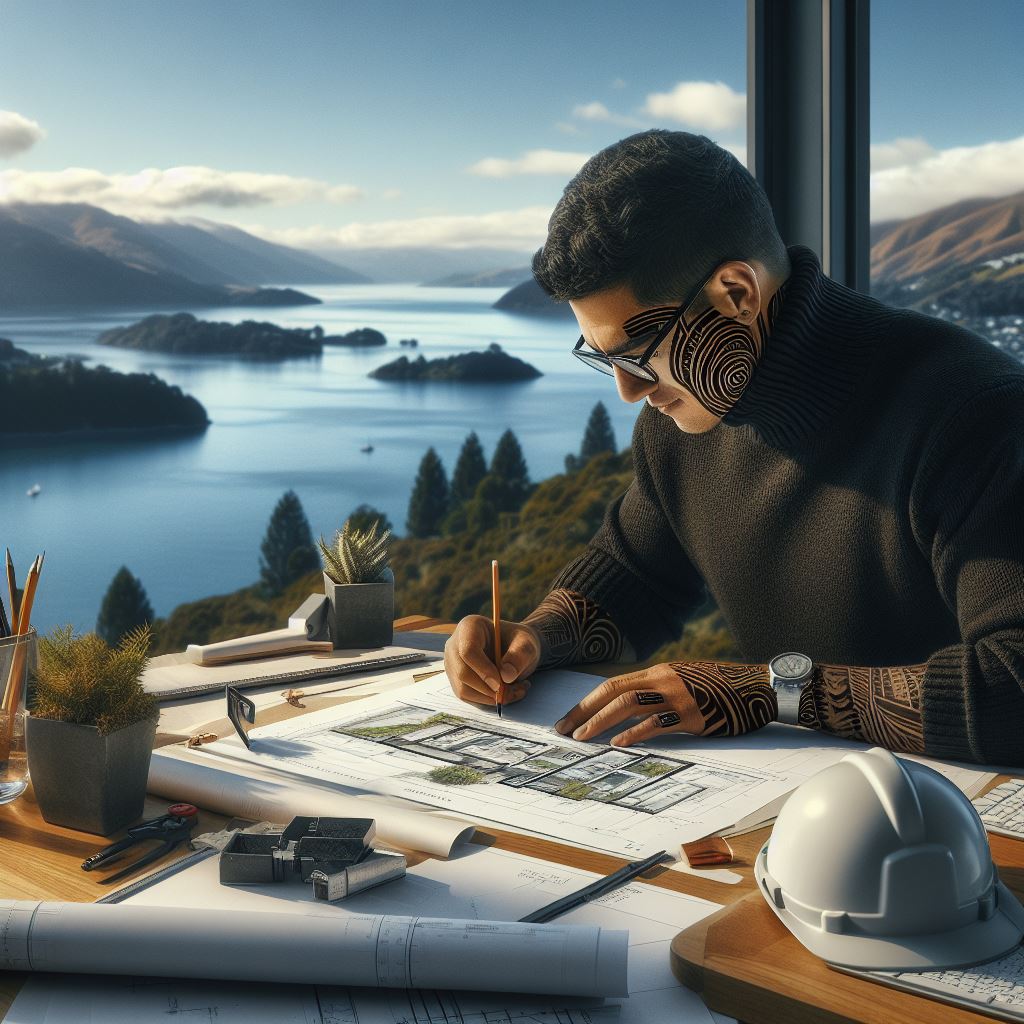Introduction
Green architecture, emphasizing sustainability, prioritizes environmental and social factors in building design and construction.
New Zealand demonstrates a strong commitment to these principles through various initiatives.
The country’s emphasis on eco-friendly practices reflects its recognition of the importance of minimizing environmental impact.
With its vast natural beauty and rich biodiversity, New Zealand serves as a model for sustainable development.
Through innovative designs and conservation efforts, the nation strives to reduce its ecological footprint and promote environmental stewardship.
Embracing green architecture not only benefits the environment but also enhances the well-being of inhabitants.
By fostering sustainable practices, New Zealand aims to create a healthier and more resilient built environment.
Additionally, the country’s dedication to sustainability aligns with global efforts to address climate change and promote sustainable development goals.
Overall, New Zealand’s commitment to green architecture reflects its progressive approach to building design and its recognition of the importance of environmental responsibility.
Green architecture
Green architecture, also known as sustainable architecture, encompasses design strategies that reduce energy consumption and waste production.
It prioritizes the use of renewable materials and resources, along with efficient building systems.
The goal is to create structures that are not only visually appealing but also environmentally responsible.
NZ’s commitment to sustainability
In New Zealand, the commitment to sustainability is evident in the country’s policies and practices.
The government actively promotes green building practices through initiatives like the Green Building Council and the Homestar rating system.
These initiatives encourage the use of eco-friendly materials, such as locally sourced timber and low-impact construction methods.
Furthermore, many architects and design firms in New Zealand prioritize sustainability when creating buildings.
They incorporate features like passive solar design, rainwater harvesting systems, and green roofs to enhance energy efficiency and minimize environmental impact.
The country’s stunning landscapes and commitment to conservation serve as an inspiration for architects to integrate natural elements into their designs, further enhancing sustainability.
Therefore, green architecture aims to create sustainable and environmentally friendly structures.
New Zealand is at the forefront of this movement, with its commitment to sustainability reflected in its policies, practices, and architectural designs.
By embracing green architecture, New Zealand continues to set an example for the rest of the world in building a greener future.
The Importance of Green Architecture
Green architecture, also known as sustainable or eco-friendly design, is gaining increasing importance in today’s world.
It focuses on reducing the negative impact of buildings on the environment and promoting a healthier and more sustainable way of living.
Environmental Benefits
- Reducing carbon footprint: Green architecture aims to minimize the emissions of greenhouse gases, which contribute to climate change.
- Preserving natural resources: It promotes the efficient use of resources such as water, energy, and materials, reducing waste and depletion.
Health Benefits for Occupants
- Improved air quality: Green buildings prioritize good ventilation and use low VOC (volatile organic compound) materials, creating healthier indoor environments.
- Increased natural light: Design elements that maximize natural light not only reduce the need for artificial lighting but also have positive effects on occupants’ well-being and productivity.
Economic Advantages
Green buildings save money on energy bills by integrating energy-efficient systems and technologies.
Sustainable design strategies reduce maintenance and operational costs over the building’s lifespan.
Green architecture considers environmental, health, and economic aspects throughout the entire process.
Architects design green buildings, employing strategies like passive design, energy-efficient systems, and water conservation.
They choose sustainable materials and install green roofs and walls to improve insulation and reduce stormwater runoff.
Green architecture positively impacts urban planning, making cities more environmentally friendly and attractive.
Governments and certification programs encourage green building practices through incentives and certifications like LEED.
Basically, green architecture offers environmental, health, and economic advantages, promoting a sustainable approach to construction.
Read: The Future of Electrical Engineering in NZ
NZ’s Leadership in Sustainable Design
Overview of NZ’s sustainable design principles
New Zealand has long been at the forefront of sustainable design and green architecture.
Its commitment to creating environmentally friendly and energy-efficient buildings has made it a global leader in sustainable design.
In this section, we will provide an overview of NZ’s sustainable design principles, discuss government initiatives promoting green architecture, and highlight influential organizations in the field.
NZ’s sustainable design principles are rooted in the country’s unique environmental challenges and its commitment to preserving its natural beauty.
These principles emphasize the use of renewable resources, energy efficiency, and minimizing waste.
By adopting these principles, NZ aims to create a built environment that harmonizes with nature and minimizes its ecological footprint.
Personalized Career Consulting
Unlock your potential with expert career advice tailored to your goals. Get personalized guidance and actionable steps toward your dream career in New Zealand.
Get StartedGovernment initiatives promoting green architecture
The government of New Zealand has played a crucial role in promoting sustainable design.
It has implemented several initiatives to encourage architects and builders to embrace green practices.
One of the most significant initiatives is the New Zealand Green Building Council’s Green Star rating system.
This system evaluates buildings based on their environmental impact, energy efficiency, and use of sustainable materials.
By providing certifications and incentives for green building practices, the government has incentivized the industry to prioritize sustainability.
In addition to government initiatives, several influential organizations have been instrumental in promoting sustainable design in NZ.
The Sustainable Business Network is one such organization
It brings together businesses, government agencies, and community groups to collaborate on sustainable solutions.
The network provides resources, education, and networking opportunities to promote sustainable practices in various sectors, including architecture and design.
Another notable organization is the NZ Institute of Architects.
It is committed to promoting architectural excellence while also considering environmental and social factors.
The institute encourages architects to embrace sustainable design principles and integrates them into professional development programs and awards.
Through its initiatives, the NZ Institute of Architects aims to raise awareness and promote the adoption of sustainable design practices.
The use of sustainable building materials is another important aspect of green architecture in NZ.
Timber, in particular, plays a significant role in sustainable design.
NZ has vast forests, and sustainably managed timber is readily available.
Timber is a renewable resource that has a lower carbon footprint compared to traditional building materials like concrete and steel.
By incorporating timber into building design, NZ architects contribute to a more sustainable and eco-friendly construction industry.
Furthermore, NZ’s government regulations have played a crucial role in promoting sustainable design.
Building codes and regulations have been revised to enforce energy efficiency standards, waste management practices, and the use of sustainable materials.
The aim is to ensure that all new constructions and renovations adhere to sustainable design principles and contribute to a greener future.
In short, New Zealand’s leadership in sustainable design is evident through its commitment to sustainable design principles, government initiatives promoting green architecture, and influential organizations working towards sustainable solutions.
By embracing environmentally friendly practices and prioritizing sustainability, NZ is setting an example for the rest of the world to follow.
The country’s efforts in green architecture not only benefit the environment but also contribute to a healthier and more sustainable future for its residents and future generations.
Read: NZ Electrical Engineering: Industry Insights
Iconic Green Architecture in NZ
Description and Analysis of Notable Sustainable Buildings in NZ
New Zealand is renowned for its commitment to sustainable design and architecture.
The country boasts several iconic buildings that showcase innovative green practices and have become symbols of sustainability.
One such building is the Energy Centre in Wellington.
Designed by Architecture Workshop, it incorporates a range of sustainable features, including rainwater harvesting, solar panels, and a green roof.
These elements not only reduce its environmental impact but also create a visually appealing and functional space.
Another notable sustainable building is the Cardboard Cathedral in Christchurch.
Built as a temporary replacement for the earthquake-damaged cathedral, it uses recycled cardboard tubes as structural elements.
This unique design not only showcases the potential of sustainable materials but also provides a light-filled and acoustic-friendly space.
The Earthship in Taupo is another outstanding example of sustainable architecture.
This self-sufficient home is made from recycled materials and utilizes passive heating and cooling systems, solar power, and greywater recycling.
It demonstrates how sustainable design can be applied to residential buildings, providing a model for future eco-friendly housing solutions.
Presentation of Various Architectural Styles and Approaches
New Zealand’s commitment to sustainability is reflected in the diversity of architectural styles and approaches used in green buildings.
The Wharehoka Building in New Plymouth, designed by Tennent + Brown Architects, showcases a contemporary approach to green design.
Its use of locally sourced materials, natural ventilation, and thermal massing techniques result in an energy-efficient and visually striking building.
On the other hand, the Pukio House in Auckland showcases a more traditional approach to sustainability.
Designed by Crosson Architects, this building utilizes passive solar design principles and sustainable materials like timber to create a warm and inviting space that connects with its natural surroundings.
Showcase of Innovative Features and Sustainable Practices Used
New Zealand’s iconic green buildings often feature innovative and sustainable practices that push the boundaries of design.
The Scape Public Art Centre in Christchurch exemplifies this with its unique vertical green wall.
Designed by Sandbox Architects, the building incorporates a living facade that not only provides insulation but also enhances the aesthetics and biodiversity of the urban environment.
The Breathe building in Wellington is another example of innovative sustainable design.
Designed by Studio Pacific Architecture, it utilizes an innovative natural air ventilation system inspired by termite mounds.
This system ensures excellent indoor air quality while significantly reducing energy consumption.
In fact, New Zealand’s commitment to green architecture is evident in its iconic sustainable buildings.
These structures not only showcase various architectural styles and approaches but also feature innovative features and sustainable practices.
They serve as inspiring examples of how sustainable design can create visually appealing spaces while minimizing environmental impact.
Read: Essential Skills for NZ’s Electrical Engineers

Sustainable Materials and Technologies
In the field of green architecture, one of the fundamental aspects is the use of sustainable materials and cutting-edge technologies that promote sustainability.
Eco-friendly Materials
Green architects prioritize the use of eco-friendly materials in their designs, aiming to reduce the environmental impact of construction and create healthier living environments.
Examples of sustainable materials commonly used in green architecture include:
- Bamboo: Known for its rapid growth and durability, bamboo is a renewable resource that can be used for flooring, furniture, and structural elements.
- Recycled Steel: By using recycled steel, architects can reduce energy consumption and lower carbon emissions associated with the production of new steel.
- Recycled Glass: Repurposing glass reduces the need for raw materials and decreases the amount of waste sent to landfills.
- Low-VOC Paints: These paints have lower levels of volatile organic compounds, which contributes less to indoor air pollution and improves air quality.
- Reclaimed Wood: Using reclaimed wood from old structures reduces deforestation and gives a new life to materials that would otherwise go to waste.
- Natural Insulation: Materials like recycled denim, cellulose, and cork are used as insulation alternatives to traditional fiberglass, providing better energy efficiency.
With these eco-friendly materials, green architects can create aesthetically pleasing and sustainable buildings that nurture a healthier future for both individuals and the planet.
Cutting-edge Technologies
Alongside the use of sustainable materials, green architecture embraces cutting-edge technologies that further promote sustainability and energy efficiency.
Some examples of these innovative technologies include:
Transform Your Career with a Professional CV and Cover Letter
Stand out to employers with an ATS-optimized resume and tailored cover letter designed to match your dream role. Let us craft your job application materials for success!
Get Started- Solar Panels: By harnessing the power of the sun, buildings equipped with solar panels can generate electricity, reducing reliance on non-renewable energy sources and lowering utility costs.
- Geothermal Systems: Utilizing the Earth’s natural heat, geothermal systems provide heating, cooling, and hot water by tapping into the stable temperatures found underground.
- Smart Lighting Systems: Using sensors and automation, smart lighting adjusts the intensity and timing of lights, optimizing energy usage and reducing electricity consumption.
- Greywater Recycling: This system collects and treats wastewater from sinks, showers, and washing machines, allowing it to be reused for irrigation and flushing toilets.
- Rainwater Harvesting: Collecting rainwater for non-potable uses such as landscape irrigation helps conserve water and reduce the strain on local water supplies.
- Green Roofs: Buildings with vegetated roofs improve insulation, reduce stormwater runoff, promote biodiversity, and mitigate the urban heat island effect.
These technologies not only contribute to energy efficiency and reduced environmental impact but also provide long-term cost savings for building owners and occupants.
All in all, sustainable materials and innovative technologies play a crucial role in green architecture.
By incorporating eco-friendly materials and cutting-edge solutions, architects can design structures that harmonize with the environment while creating healthier and more energy-efficient spaces.
Read: Interview: NZ Electrical Engineers’ Success Stories
Challenges and Solutions in Green Architecture
Implementing sustainable designs in green architecture presents several challenges, but with creative solutions, these obstacles can be overcome.
This section explores the identification of challenges, discusses solutions to common problems, and showcases successful case studies and outcomes.
Challenges faced in implementing sustainable designs
The journey towards sustainable architecture is not without its hurdles. Here are some challenges frequently encountered:
- High initial costs: Sustainable materials and technologies often come at a higher price, increasing construction budgets.
- Limited availability of eco-friendly materials: Finding suitable, locally sourced green materials can be challenging in some regions.
- Resistance to change: Convincing clients, contractors, and stakeholders about the benefits of sustainable designs can be a struggle.
- Complex design requirements: Meeting the diverse needs of sustainable architecture while staying aesthetically pleasing can be a balancing act.
- Government regulations and permits: Navigating bureaucratic hurdles and complying with strict standards can delay projects.
Solutions to common obstacles
To overcome these challenges, architects and designers must employ innovative solutions:
- Cost-effectiveness: Investing in sustainable designs may have higher upfront costs, but long-term savings from energy efficiency can offset these expenses.
- Promoting awareness: Educating clients and stakeholders about the environmental and financial benefits of green architecture can change perceptions.
- Creating incentives: Governments can offer tax breaks, grants, or other incentives to encourage the adoption of sustainable designs.
- Collaboration and partnerships: Architects, engineers, and suppliers can work together to identify and address the challenges of sourcing eco-friendly materials.
- Innovative design approaches: Balancing functionality and aesthetics requires creative thinking and out-of-the-box design solutions.
- Streamlined permitting processes: Advocating for streamlined regulations and shorter permit waiting times can help expedite green architecture projects.
Showcasing successful case studies and outcomes
Despite the challenges, many architects and designers have succeeded in implementing sustainable designs. These case studies highlight the positive outcomes:
- The Pegasus Bay Coastal Housing Project: This development achieved carbon-neutral status by incorporating passive solar design and rainwater harvesting systems.
- The Christchurch Civic Building: This earthquake-resistant structure features a highly efficient thermal envelope and utilizes solar panel arrays, resulting in reduced energy consumption.
- The Auckland Art Gallery Toi o Tāmaki: This renovation project transformed an existing building into an energy-efficient space by incorporating natural ventilation and lighting systems.
- The Wellington Eco-City Tower: This mixed-use tower utilizes wind turbines, solar panels, and rainwater collection systems to provide renewable energy and decrease its environmental footprint.
These success stories demonstrate that sustainable designs can be both environmentally friendly and economically viable.
In review, implementing sustainable designs in green architecture comes with challenges, but with the right solutions, these obstacles can be surmounted.
By identifying the challenges, discussing solutions, and showcasing successful case studies, the path towards a more sustainable built environment becomes clearer.
Future of Green Architecture in NZ
Upcoming trends and advancements in sustainable design
As New Zealand continues to prioritize sustainability, the future of green architecture looks promising.
With constant exploration of upcoming trends and advancements in sustainable design, the country is set to lead the way in eco-friendly construction.
Architects and designers are constantly pushing the boundaries of sustainable design, searching for innovative materials and technologies.
This exploration ensures that green architecture will continue to evolve and adapt to changing environmental needs.
Additionally, the government’s commitment to sustainability is evident through its support and incentives for green building projects.
There is anticipation of further government support, which will contribute to the growth and success of green architecture in NZ.
Further government support and incentives
These government incentives provide financial relief and encourage architects and developers to adopt sustainable practices.
Boost Your Career with a Standout LinkedIn Profile
Attract recruiters and expand your network with a fully optimized LinkedIn profile tailored to highlight your strengths and professional goals. Let your profile open doors to new opportunities!
Get OptimizedAs a result, green buildings are becoming more prevalent, leading to a positive impact on the environment.
Potential impact of green architecture on NZ’s global standing
Green architecture not only benefits the local environment but also has the potential to elevate New Zealand’s global standing.
The country’s commitment to sustainability and its emphasis on eco-friendly design can position NZ as a leader in the field.
The global community recognizes the importance of sustainable development, and with its innovative designs, New Zealand can inspire other countries to embrace green architecture.
This would have a profound impact on the world’s fight against climate change.
Furthermore, the potential impact of green architecture on NZ’s economy cannot be overlooked.
As the demand for sustainable buildings increases, there will be a boom in the construction industry.
This growth will lead to job creation and economic prosperity.
Green buildings also offer long-term cost savings through reduced energy consumption and operational expenses.
With rising energy costs and growing environmental concerns, the economic benefits of green architecture are becoming more appealing to developers and investors.
One of the key areas where green architecture in NZ is expected to thrive is in the residential sector.
As homeowners become more conscious of their ecological footprint, there is a rise in demand for sustainable homes.
The future of green architecture in NZ lies in the integration of renewable energy sources, efficient insulation, and water-saving technologies into residential construction.
This will create self-sufficient and environmentally friendly homes for a sustainable future.
Review, the future of green architecture in New Zealand looks promising.
The exploration of upcoming trends and advancements, anticipation of government support, and the potential impact on the country’s global standing all contribute to a thriving sustainable design industry.
As NZ continues to prioritize environmental sustainability, it can inspire other nations to embrace eco-friendly practices.
The economic benefits, job creation, and improved quality of life make green architecture a vital part of the country’s future development.
Conclusion
New Zealand’s dedication to sustainable architecture is evident through its commitment to green initiatives.
These endeavors not only benefit the environment but also enhance the well-being of residents.
By prioritizing green architectural designs, New Zealand aims to minimize its ecological footprint while promoting a healthier and more sustainable way of living.
This approach encompasses various strategies such as energy efficiency, waste reduction, and the use of eco-friendly materials.
Through sustainable architecture, buildings can achieve lower energy consumption, reduced greenhouse gas emissions, and improved indoor air quality.
Additionally, green spaces and natural ventilation contribute to a healthier and more comfortable living environment.
New Zealand’s leadership in sustainable architecture serves as an inspiration for other countries to adopt similar practices.
By embracing green initiatives, communities can mitigate the effects of climate change and create a more resilient future for all.
Continued exploration and support for green architectural initiatives are essential for driving positive environmental change and fostering sustainable development in New Zealand and beyond.




